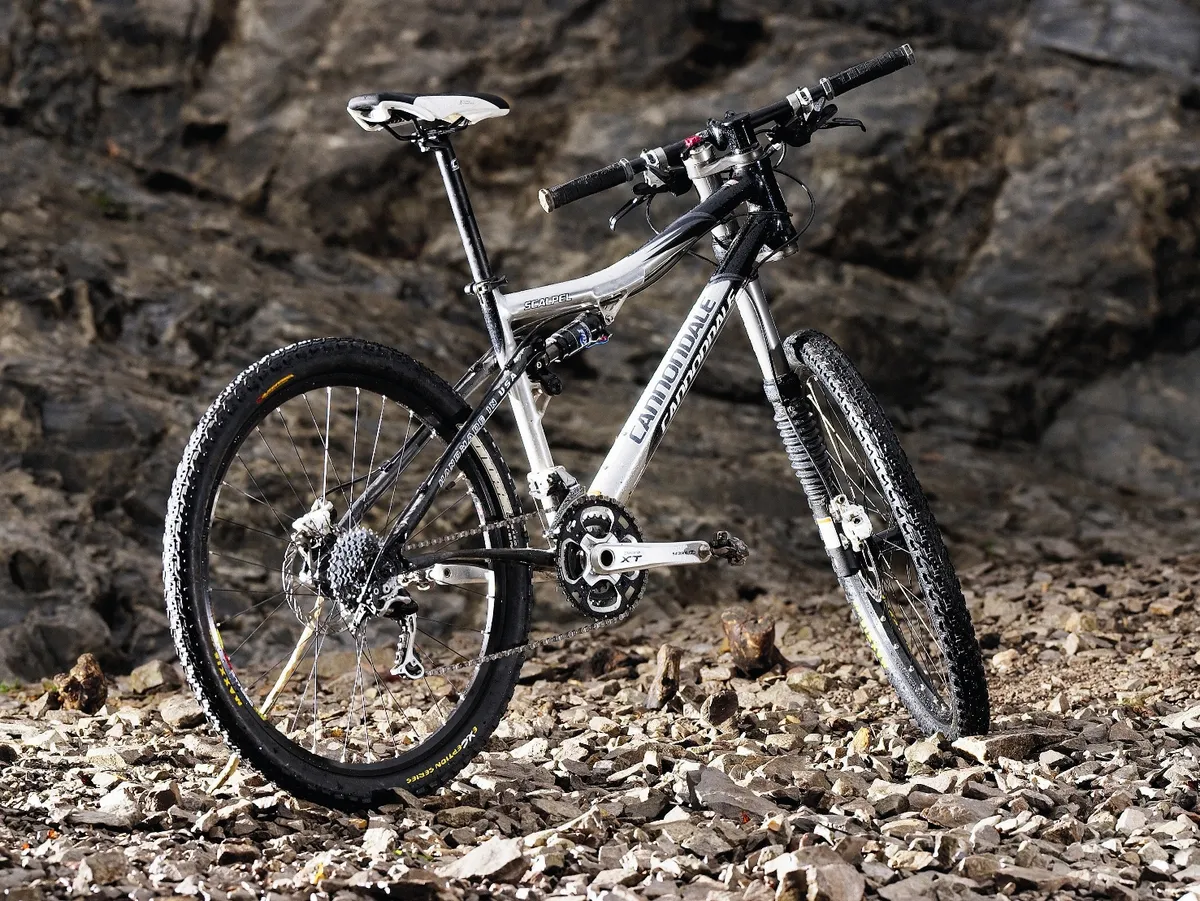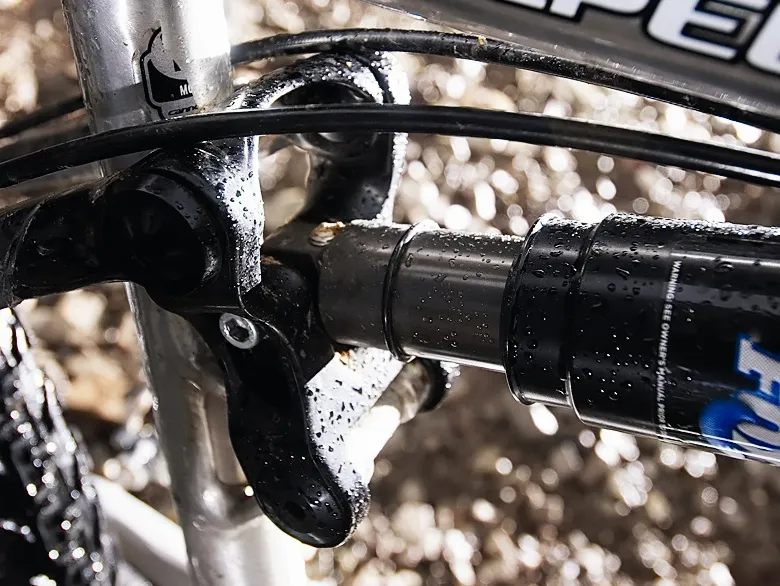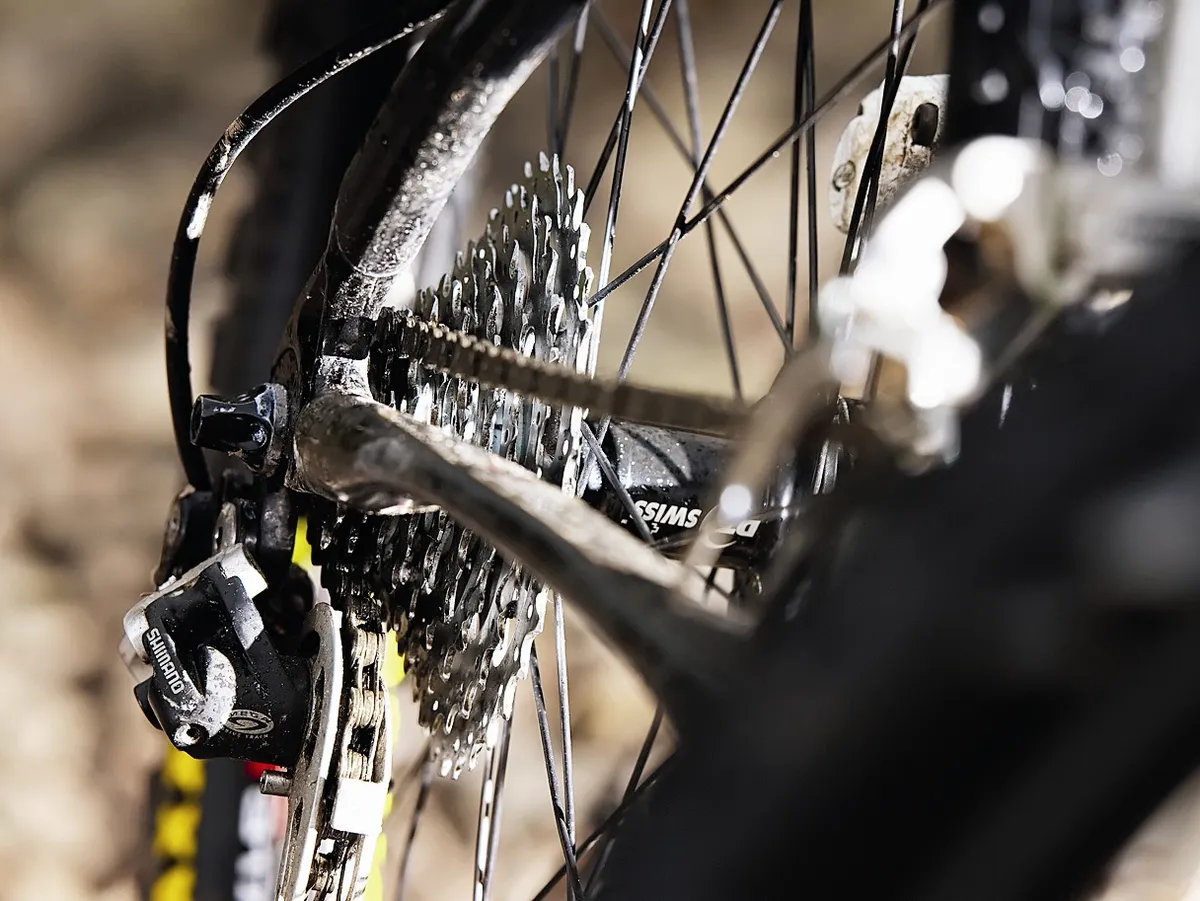It’s reported that the Cannondale race team was horrified when it heard their precious Scalpel race bikes were to be replaced. XC racers are creatures of habit and don’t like change, especially to their bikes. The racers called the old Scalpel ‘perfect’, but when engineers asked what could be improved, the racers replied with the XC mantra: ‘lighter, stronger, more travel’. So that’s what they got.
The 2008 Scalpel is set to be one of the first choices for any rider who fancies themselves as an XC or marathon racer. The Scalpel is a simple single-purpose device. It slices through singletrack with laser-guided accuracy. It’s also one of the lightest production race bikes, which helps it leap up climbs.
These attributes helped the previous Scalpel to become one of the most successful XC race bike in MTB history. With one champ already to its credit, thanks to Jakob Fuglsang’s gold medal at the 2007 World Championships in FortWilliam, the new model looks set to continue the trend.
The new model is available with either an alloy or carbon fibre mainframe. With Cannondale continuing to make some of the smoothest-looking alloy welds, it’s actually quite hard to tell them apart; only the warmth of the carbon to touch makes it clear which is which. Of course, there’s a weight penalty with the alloy, but not as much as you might expect. The Scalpel Carbon 2 weighs 25.90lb and the Scalpel 3 (alloy) weighs 25.97lb.
First impressions
Jumping on the Scalpels, the saddle-to-bar relationship felt nigh-on perfect, making the rider feel planted, comfortable and ready to take on a long, long ride. That’s a great feeling to have when you swing a leg over a new bike, especially one that you need to be able to suffer on.
Get going and drop into a smooth tempo and you feel well centred on the bike. It doesn’t feel as long as the marathon-specific Cannondale Rush, and most XC racers will enjoy that. You can easily load and unweight the front end, making traversing technical race tracks not just easy, but also fun.
Head the bikes downhill and both the alloy and carbon Scalpels begin to show the pedigree that comes from years of R&D experience. They’re not going to make great descenders with a seat up, low flat bar stance, but the handling is so good that you at least get down if needs be. Get into a tight gravel switchback with a serious-looking drop and the bike responds instinctively to late braking. Nose in tight, dab of rear brake, flick the hips and we’re round, and ‘big ringing’ for the next one.
Uphill is no different either, as the poise and balance at slow speeds are second to none. If you have to slow down halfway round an uphill switchback, there’s no wobble or panic from the bike. It gives you time to reassess and reapply the torque to continue up the mountain.
Stamp on the pedals and you’re greeted by a satisfyingly firm feeling. It’s the result of 10-15 per cent improvements in stiffness for the carbon and alloy Scalpels respectively over their previous incarnations. Thus far in the test ride, neither alloy nor carbon frame is showing any stand-out advantages.
In for a shock
In keeping with the original Scalpel, to save weight and make the chassis one of the least mechanical on the race circuit, Cannondale engineers made the rear end without a pivot at the bottom bracket. Instead, carbon leaf spring chainstays are designed to flex enough to give 100mm of travel at the shock.
So how effective is a carbon rear end that doesn’t have any links or pivots (save for a small swing-link mounted to the front side of the seat tube to isolate the rear shock)? To find out, we rode the bikes at 25 per cent sag. To our surprise when we looked down, the rear end was moving freely, easily supplying the advertised 100mm of rear wheel travel. Assuming the Cannondale Tech boffins have done their sums properly, their ‘Living Hinge’ carbon rear end should be able to keep this spring action up for many years of hard trail use.
Both Scalpels came from Cannondale with the Fox RP3 rear shock rebound dials wound right off and minimum Pro Pedal applied. The result is a pogo stick ride. As we rode the undamped bike on the flat, smooth trail, we were fully aware of pedal-induced shock actuation. The swing link was happily ‘bobbing’ away as we spun the pedals. It happened in all three rings and was definitely noticeable from the saddle.
The sag was set at 25 per cent (as per Cannnondale’s recommendations) so more air wasn’t the answer, but more damping was. Four to five clicks in from no damping on the Fox shock gave a sense of stability under power without muting the performance of the rear end and stopping it from tracking the ground. More made the rear end feel dead, while less got us back into pogo-land.
We weren’t expecting the bike to be so sensitive to rear shock adjustment, and it would’ve been nice to have had a wider range of adjustments outside of those required just to make the bike ridable. Still, in the right setting it felt good.
We had nothing but praise for the carbon Lefty Speed Carbon SL DRL 110 fork we fitted to our long-term Rush last year. The alloy-legged Lefty Speed 110 DLR2s on the new Scalpels are slightly cheaper than the carbon ones, but technically identical.
The alloy Lefty matched the precise steering and stiffness of the carbon version, but something about the ride made the front end feel a bit ‘suffocated’, unlike the crisp and clear carbon fork. Maybe it’s because these alloy Lefty Speed 110 DLR2’s are almost brand new and need some more miles on them.
Pick up the pace
The 100mm travel Scalpel rolls easily, and the pick-up from standstill is so good it feels like it’s meant to move forward. The Rush feels like this too, as did the old Scalpel. Cannondale has many years of feedback from world-class XC racers to know what riders need from a bike in order to get to the finish line in first place, and that knowledge was used to full extent on the Scalpel.
There’s a fly in the ointment, though. The Scalpel is supposed to be a pure XC race bike from the ground up: light, incisive, flighty, a thoroughbred straining to gallop away from the field at the first sign of the spurs from the rider. However, it’s this get-up-and-go from normal trail speeds to race pace which seemed to have got-up-and-gone from both the alloy and carbon Scalpels we rode.
For instance, you’re rolling along at 12-15 mph – normal ‘getting there’ trail speed – when suddenly it’s time to drop the hammer. Maybe you’re racing and you need to pass another racer. Punch down a sprocket or press on the pedals a bit harder and you’d expect this bike to light the afterburners and disappear up the trail, but it just didn’t happen with either of the Scalpels.
At first we looked at the Maxxis Monorail UST tyres specced on the bikes as culprits. But they roll well, grip better than you’d think and they’re light enough to be on a bike of this calibre. A change of tyres to Continental Mountain Speed SuperSonic 2.1s made a bit of a difference. But with the rear shock set up correctly and light rubber on the rims, we were perplexed at this feeling of ‘power lag’ when jumping on the gas.
Naming and shaming
With so much else going right for both the Scalpel models, it was annoying that there were a few loose ends of spec choice and poor design.
One was the ‘clackety-clack’ of the full outer cabling hitting the frame on bumpy ground. The transmission and rear brake cables pass though one set of cable guides at the head tube – routing them at about five o’clock under the top tube. From there they continue under the top tube, through the rear shock mount, and straight into the cable guides on the seat stays. The problem is that if you run the bike soft and active – as you may choose to do – then the rear shock compresses and then re-extends, causing the cables to gently slap the underside of the top tube. Run the bike firmer and it stops. With more cable guide mounts you could run it anyway you wished – as it is, ours now wears an unsexy zip tie around the top tube.
Right then, who chose the Fizik Nisene saddle? Okay, it’s a perfectly good and comfortable saddle – for a trail bike. For a race bike like this, it’s both heavy and so overly effective at damping trail sensation from your skinny racing bottom that you can’t really tell what’s happening under your wheel. Racing cars have racing seats and racing runners wear lightweight trainers, so why couldn’t we have something better for our bottom? Top-end Scalpels get a slightly more racy Fizik Gobi, although we might even plump for the thinner Fizik Aliante. This could be an immediate upgrade before leaving the shop.
Flat bars are a staple XC touch, and they feel good and perfectly at home on the Scalpel, but Cannondale, please, why not make them 24in wide and let us trim them? Oh, and add a dash more sweep while you’re at it.
Finally, race bikes get ridden when the race is scheduled, not whenever it looks like dry weather. Sod the extra 50g of weight and spec some lock-on style grips. There’s nothing more infuriating than riding a couple of grand’s worth of bike with a spinning grip.
Both bikes came with tyres that are better choices for weekend warriors than wannabe racers. The Maxxis Monorails are great tyres that roll easily, but they’re Ford Mondeo equipment on an F1 car. Most riders will keep them for training or trail riding and invest in some lighter, more fleet-of-foot rubber to help inject real ‘race pace’ into the Scalpel, especially for those dropping-the-hammer moments.
The tough part
We’d assumed the rougher trails would give the alloy Scalpel a chance to shine. A bit more feedback from the metal frame should lead us, guide dog-style, through the danger. But no, the alloy bike preferred the rides where the terrain was smooth and flowing.
Surprisingly, it was the carbon bike which liked the rufty-tufty challenges of the home trails more. Maybe it was the damping qualities of the carbon coming through, but with the trend towards smooth racers being on carbon, it was odd to feel more at home on the carbon when the trail got rougher.
We tried swapping the wheels to see if that made a difference, but the result was the same. In the end, I came to pick the alloy bike nine times out of 10. Maybe it suits my style of riding better or maybe I’m missing something about the carbon. If the bikes were only for ‘show’ I’d get the carbon, but bikes like this are for ‘go’, and I got the most go out of the alloy. Before the test I’d have bet the house that it would certainly be the other way around. They say it’s horses for courses, and never was a better expression available than for these two Scalpels. The question is though, which horse is for you?
Verdict
There’s little doubt that the Scalpel in either frame material is a serious XC race machine. Fit lighter tyres and put the finishing kit on a diet and you’re ready to win races.


